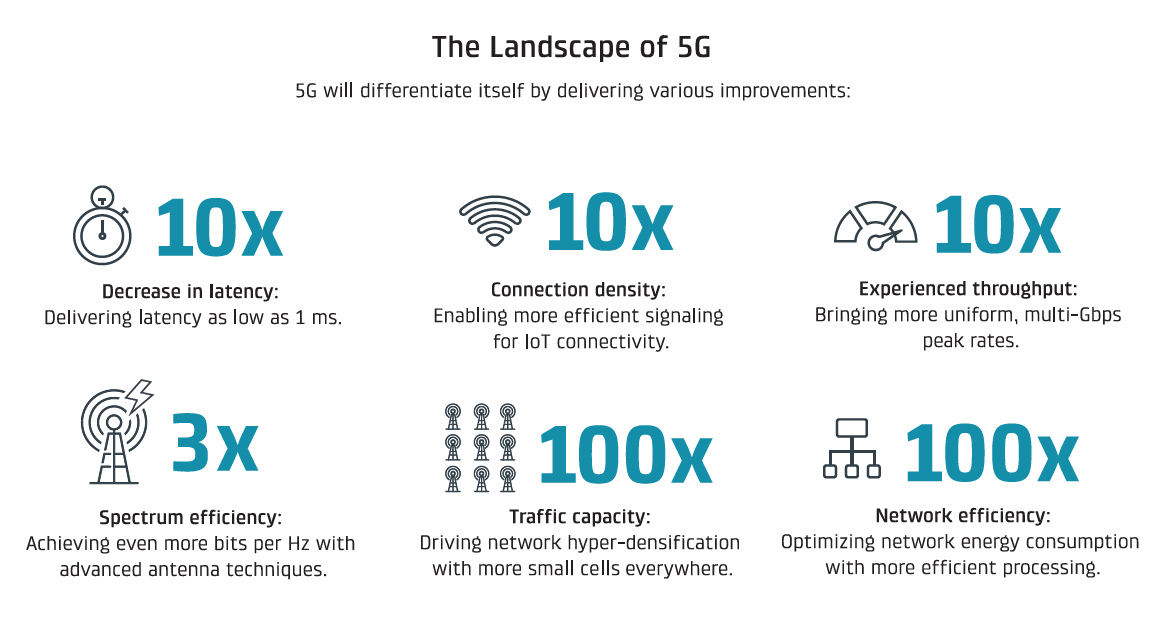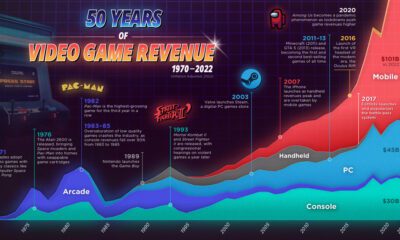Technology
5G: The Next Generation of Mobile Connectivity
Just before the smartphone revolution, Nokia was by far the world’s most popular mobile handset manufacturer.
However, despite selling 250 million units of its two most popular block-shaped models in the mid-2000s, the Finnish company ended up being woefully late to the smartphone party. Not only was the company ill-equipped to match the iPhone and Blackberry in terms of technology and design features, but Nokia also failed to foresee how exponential advances in mobile connectivity would change how people ultimately used their devices.
As true broadband connectivity shaped the mobile experience, the phone was no longer just a phone – it was transformed into a seamless hub for any and all digital activity.
The 5G Experience
In the coming years, the newest generation of mobile connectivity – 5G – will roll out and change what is possible again. With maximum speeds up to 1,000x faster than 4G, this new technology will again shift consumer behavior, as well as how we view smartphones, communications, IoT, gaming, and AR/VR.
Today’s infographic comes to us from Cradlepoint, and it highlights how the switch to 5G is unfolding, and what it could mean to you.

The switch to 5G is already well underway, with countries like China and the United States spending billions of dollars since 2015 to get infrastructure in place.
And by 2035, it’s estimated that 5G will enable $12.3 trillion of global economic output, according to a recent report from IHS Markit.
What 5G Will Mean
Here are some of the key differentiators that 5G will provide to future wireless connectivity:
10x decrease in latency
Latency will be as low as 1ms.
10x increase in connection density
This will enable more efficient signaling for IoT connectivity.
3x spectrum efficiency
More bits per Hz will be achieved with advanced antenna techniques.
100x traffic capacity
This will drive network hyper-densification with more small cells everywhere.
10x experienced throughput
Multi-Gbps peak rates will be achieved with uniformity.
100x network efficiency
Network energy consumption will be optimized through more efficient processing.
The switch to 5G will mean longer battery life for devices, lower costs, enhanced cellular footprints, higher throughput, enhanced capacity, low latency, and virtually no packets dropped.
More importantly, as a result of these changes, how mobile connectivity looks in 10 years may be as unrecognizable as the Nokia block phone era does to us today.
Technology
All of the Grants Given by the U.S. CHIPS Act
Intel, TSMC, and more have received billions in subsidies from the U.S. CHIPS Act in 2024.

All of the Grants Given by the U.S. CHIPS Act
This was originally posted on our Voronoi app. Download the app for free on iOS or Android and discover incredible data-driven charts from a variety of trusted sources.
This visualization shows which companies are receiving grants from the U.S. CHIPS Act, as of April 25, 2024. The CHIPS Act is a federal statute signed into law by President Joe Biden that authorizes $280 billion in new funding to boost domestic research and manufacturing of semiconductors.
The grant amounts visualized in this graphic are intended to accelerate the production of semiconductor fabrication plants (fabs) across the United States.
Data and Company Highlights
The figures we used to create this graphic were collected from a variety of public news sources. The Semiconductor Industry Association (SIA) also maintains a tracker for CHIPS Act recipients, though at the time of writing it does not have the latest details for Micron.
| Company | Federal Grant Amount | Anticipated Investment From Company |
|---|---|---|
| 🇺🇸 Intel | $8,500,000,000 | $100,000,000,000 |
| 🇹🇼 TSMC | $6,600,000,000 | $65,000,000,000 |
| 🇰🇷 Samsung | $6,400,000,000 | $45,000,000,000 |
| 🇺🇸 Micron | $6,100,000,000 | $50,000,000,000 |
| 🇺🇸 GlobalFoundries | $1,500,000,000 | $12,000,000,000 |
| 🇺🇸 Microchip | $162,000,000 | N/A |
| 🇬🇧 BAE Systems | $35,000,000 | N/A |
BAE Systems was not included in the graphic due to size limitations
Intel’s Massive Plans
Intel is receiving the largest share of the pie, with $8.5 billion in grants (plus an additional $11 billion in government loans). This grant accounts for 22% of the CHIPS Act’s total subsidies for chip production.
From Intel’s side, the company is expected to invest $100 billion to construct new fabs in Arizona and Ohio, while modernizing and/or expanding existing fabs in Oregon and New Mexico. Intel could also claim another $25 billion in credits through the U.S. Treasury Department’s Investment Tax Credit.
TSMC Expands its U.S. Presence
TSMC, the world’s largest semiconductor foundry company, is receiving a hefty $6.6 billion to construct a new chip plant with three fabs in Arizona. The Taiwanese chipmaker is expected to invest $65 billion into the project.
The plant’s first fab will be up and running in the first half of 2025, leveraging 4 nm (nanometer) technology. According to TrendForce, the other fabs will produce chips on more advanced 3 nm and 2 nm processes.
The Latest Grant Goes to Micron
Micron, the only U.S.-based manufacturer of memory chips, is set to receive $6.1 billion in grants to support its plans of investing $50 billion through 2030. This investment will be used to construct new fabs in Idaho and New York.
-

 Debt1 week ago
Debt1 week agoHow Debt-to-GDP Ratios Have Changed Since 2000
-

 Markets2 weeks ago
Markets2 weeks agoRanked: The World’s Top Flight Routes, by Revenue
-

 Countries2 weeks ago
Countries2 weeks agoPopulation Projections: The World’s 6 Largest Countries in 2075
-

 Markets2 weeks ago
Markets2 weeks agoThe Top 10 States by Real GDP Growth in 2023
-

 Demographics2 weeks ago
Demographics2 weeks agoThe Smallest Gender Wage Gaps in OECD Countries
-

 United States2 weeks ago
United States2 weeks agoWhere U.S. Inflation Hit the Hardest in March 2024
-

 Green2 weeks ago
Green2 weeks agoTop Countries By Forest Growth Since 2001
-

 United States2 weeks ago
United States2 weeks agoRanked: The Largest U.S. Corporations by Number of Employees















